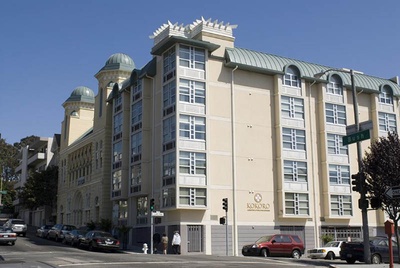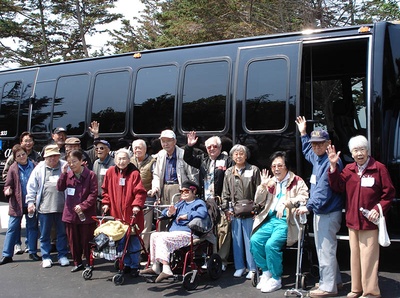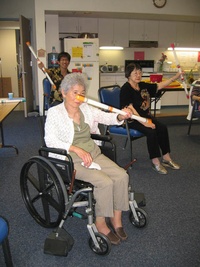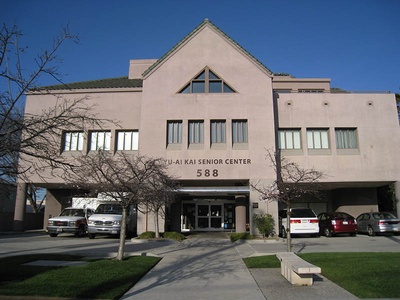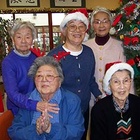>> Part II-1
For those in need of a more intensive level of care than what Kimochi provides, Bay Area seniors can go to Kokoro, a nearby non-profit assisted-living complex that opened in 2003. The facility grew out of a 13-year-long effort by a consortium of church groups, and is headed by a volunteer board of directors, a staff of 27 full-time and 20 part-time employees, and a corps of 25 volunteers, some of whom are old enough to be residents.
Kokoro (the Japanese word for “heart” that combines notions of heart, mind and inner spirit) is located at 1881 Bush Street, in close proximity to Japanese Buddhist, Shinto and Presbyterian churches and a block from the Japantown mall. Residents can walk to the yearly obon festival, eat rice and Japanese foods daily, and participate in the annual cherry blossom festival and other cultural events in the neighborhood.
Kokoro offers 37 of its 54 apartments at below-market rates, using a sliding-scale fee system based on a review of prospective residents’ income and assets. Depending on the level of care needed, income level and availability of discounted rates, the cost of a private studio apartment can range from $1,950 to $5,100 dollars per month, says Kokoro Executive Director Kirk Miyake. Since the facility does not offer skilled nursing or rehabilitative care, Kokoro, like Kimochi, does not receive Medi-Cal or Medicare funding. The facility does, however, attract new residents by providing short-term care to seniors recovering from surgery or other hospitalization. “In some cases,” Miyake says, “respite stays have turned into long-term occupancy when the senior sees how much Kokoro offers.”
Over the past year, Kokoro has faced a recession-driven fall in occupancy rates. Meeting its annual budget requires a 90 percent occupancy rate, but Miyake says that the organization is now running at 87 percent occupancy and has 7 vacant apartments. Some potential clients are going straight to assisted- living communities that offer support for residents suffering from advanced dementia (Kokoro can only accommodate residents evaluated to have initial stage dementia) and some seniors are opting for facilities that do not cater primarily to Nikkei but are closer to family members.
Now Kokoro is refocusing its marketing efforts to help reverse the effects of an industry-wide occupancy slump. “I joke with board members that I’m going to have to convert the rooftop into a spa for residents,” says Miyake, but he knows that he may also have to start marketing beyond the Japanese community. “Right now what brings people into Kokoro is being able to speak to someone in Japanese and the Japanese food,” says Miyake, “but that is slowly changing.” Today, 83-percent of Kokoro’s residents are Nikkei; the remaining population is a mix of different ethnicities, including Chinese, Korean, Jewish and African Americans. Miyake sometimes fields requests from prospective Chinese residents for Cantonese speaking caregivers, but he says, “It’s hard to guarantee staff who can speak a specific language other than English. Even providing a round-the-clock Japanese-speaking staff person has not been possible.”
Miyake predicts that Sansei will still feel comfortable in an all-Japanese environment for another 20 years or so, but adds, “I’m part of that group, and I don’t think I will have a problem fitting into another kind of assisted-living facility when my time comes. I grew up eating Japanese food, [A Nikkei facility] would be nice, but I could go to a place that offers a more western style of food; it’s not a requirement.” On a small scale, Kokoro’s dining room is already home to a blend of races, ethnic foods and preferences. One of Kokoro’s residents is a Caucasian man who will sometimes decline the Japanese option at mealtimes, order from the alternate menu that is always offered, and is satisfied with a hot dog or tuna sandwich. Miyake recalls one Nisei resident who preferred potatoes to rice and complained that spud dishes were not served often enough.
As with many of the Nikkei eldercare organizations I spoke to, at Kokoro, says Miyake, “Fundraising events and unsolicited donations have helped us a great deal, allowing us to maintain a robust activity program.”
Inland and to the south of these Nikkei centers, San Jose’s Yu-Ai Kai Japanese American Community Senior Service serves about 3,000 seniors a year, offering senior day services, on-site hot lunches and meals on wheels, transportation, case management social services and caregiver support groups.
Aided by a long list of community supporters and its close ties to the Japantown business community, Yu-Ai Kai has been serving the community for 35 years. Anticipating the needs of its growing number of seniors, the center adopted what it calls its “Healthy Aging Initiative” last fall, aimed at helping members from 55 to over 100 stay active, sharp-minded and fit. Especially designed to appeal to the boomer generation, activities such as healthy cooking and nutrition classes, health education programs that focus on chronic illnesses and injury prevention, and exercise classes for all members from the more active to frail seniors are planned. These activities will take place in YAK’s new Akiyama Wellness Center, scheduled to open later this month.
Yu-Ai Kai (the name means “gathering of friendship and love” in Japanese) has an annual budget of a little over $1 million, says Executive Director Sophie Horiuchi-Forrester,. It receives a mix of government and foundation grants to help fund its nutrition and senior daycare programs, and actively competes for government, corporate and foundation money, donations and sponsorship. Although the recession has taken a toll, strong community backing has so far helped YAK stay in the black.
Commenting on the increasing diversity of its community, Horiuchi-Forrester says, “Opening the doors to other ethnicities is a natural progression…we want to honor and keep our traditions, and yet recognize that our population is increasingly diverse.” A recent Nikkei cancer forum, which featured simultaneous English-Japanese translation via headsets, drew surprisingly large numbers of both JA and shin-Issei, and showed YAK that there is a hunger for health and wellness programming. YAK plans to add a support group for cancer patients, survivors and caregivers, and is contemplating an inter-generational and inter-cultural program called “Chibi and Me” to recognize the growing number of members who are helping care for their grandchildren.
The Japanese American Services of the East Bay, Inc. provides Nikkei seniors of Alameda and Contra Costa Counties with a senior center, nutrition and educational programs, case management by social workers and transportation services.
In addition to facing the same fundraising challenges as other Nikkei eldercare organizations, JASEB—which operates on a budget of less than $1 million annually—is challenged by the geographic dispersion of its members and the lack of a unifying Japantown in the area it serves, says JASEB board president Bruce Hironaka.
The organization has been involved in a multi-year process of deciding whether or not to divest two “community homes”—unlicensed family cooperatives allowed to operate as low-cost, culturally sensitive senior housing—in Hayward and Berkeley. Hironaka says the organization made the difficult decision last September to gradually phase out its affiliation with the homes; it will continue to serve as a co-sponsor of a 99-bed federally subsidized affordable-housing complex in Hayward, however.
JASEB has just completed the first strategic plan in its 39-year history, and the organization is planning a fundamental change in direction. “Our current fundraising model, where we’re heavily dependent on the Nisei generation,” says Hironaka bluntly, “is not sustainable.” Like YAK, JASEB hopes to broaden its reach by becoming a multi-generational service center focused on families. Although JASEB’s services are open to everyone, most of its participants are Nikkei. Ultimately Hironaka believes the organization will broaden its scope to serve a broader Asian Pacific Islander population, but he says, “What we heard from the community was that they were not looking for a rapid transition in this area.”
That may be so, but given the high rate of intermarriage among the Sansei and Yonsei generations, Hironaka points out, “just by focusing on the different generations of the Nikkei community we’ll in fact come to serve different ethnic backgrounds.”
The bottom line, says Sandy Mori of Kimochi, is that “until the federal government provides financial support for community-based long-term care, and as long as ninety percent of seniors want to live at home or age in place, our society and families will need to continue to help care for their elderly. Because our Japanese culture promotes and embraces this value, our JA systems of care work.”
Next: Multicultural centers in Sacramento and Los Angeles
© 2010 Nancy Matsumoto


